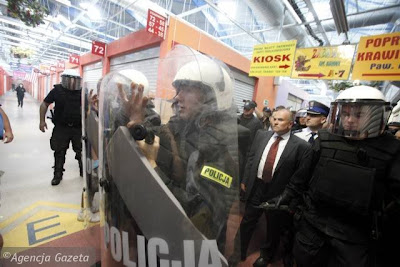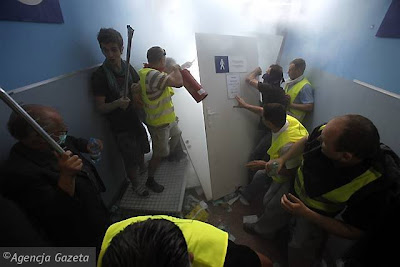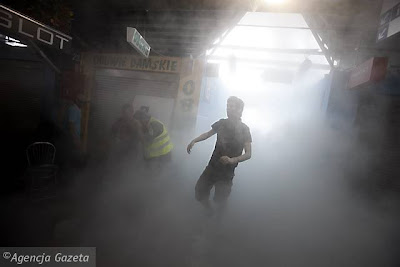


A few days ago I witnessed an excessively sad event. A huge group of merchants was thrown out (by the police) of a hall in the center of Warsaw (which they had been renting for several years), and the events turned violent and nasty, with throwing of stones and fights and tear gas and general havoc.
Although it did look like some sort of incomprehensible flash mob or other performative party, one could hardly squeeze it into the “new art” category, were it not for one significant detail: the commercial hall is to be substituted by the Museum of Modern Art. Of course, the city authorities claim the undoing of this most hideous hall is necessary for the construction of a second line of the metro, but the fact is: the temple of 90’s-style small, bad quality commerce will be replaced by the temple of contemporary art.
The obvious implication of this week’s events is: the Museum of Modern Art will arguably be the most despised building in Poland. So far, the only (extremely heated) debates about its character, name (Contemporary or Modern?), and, of course, its shape, interested only fairly elite circles. The building itself raised most controversy, with its austere, “modernist”, or, as some put it, uninspired look. But all this was nothing compared to what happened last Tuesday: the masses moved. There was naturally no talk of the museum. Yet sooner or later, the topic will appear. The Museum will be built, and the tens of thousands of people around the country who considered what happened an act of injustice will have a surprizingly clear symbolic enemy: Modern Art.
But the hundreds of people gathered at the hall entrance would not be customers anyway. Meaning, they don’t fit the profile. Not the current one, and not any potential profile of someone “we” seem to want to educate into (our) art, into (our) culture. Why? Because the social differences are so big, it is still unimaginable for the common art curator/cultural agent to think of these people as spectators, art amateurs, partners. Just as they were hardly a partner for negotiating a new commercial deal (they rejected several offers and refused to participate in further negotiations). We will hear: They are outside of the reach of... of us, the cultural people, the elites, the-educated-ones. They are a lost case.
This is obviously the moment when the conflict becomes helpless. Each party is convinced that the others are barbarians, their entire world is wrong, corrupt, and unworthy of any contact.
Do these people need us to defend them? I believe this is not a question of need. It is a question of true access to culture. Of initiatives, or rather, structures, which would allow for a potential integration of all citizens.
The Museum of Modern Art has already had many great exhibitions. But these initiatives are clearly focused on a prestigious audience, they are intellectually sophisticated, but beyond that, they don’t seem to reach out to a “larger” audience. This reaching out has been happening in many museums around the world (take the Brooklyn Museum, with their great program of interactive activities where once a month visitors can have a totally different experience of art, which includes, for instance, making their own art prints and parties with known DJs).
In Warsaw, we have a truly outstanding exhibition relating to the great Alina Szapocznikow, an artist whose work is largely unknown outside of Poland, yet here is already considered as a crucial reference for anyone interested in modern art (the exhibition ends Sunday). Her works combine eroticism with power, femininity with a great understanding of structure and drama. Possibly the most impressive among the works presented at the show is the huge female belly sculpted in marble (actually it's a double-belly), which impresses, attracts, scares, and ultimately leaves us at a (as always unbearable) distance. What is made to counteract this distance in terms of programming? Some lectures, discussions, guided tours, and a new documentary film. All this is great for me or you. Interesting indeed.
But what about the reaching out? The search for new, active audiences?
Well, many of the women present during the events at the commercial hall were convinced to join in the creative thinking about stone – they reached out, grabbed the pavement stones, and threw them at the police. I claim they did it not only because they were “part of the mob”, but also, because they were hardly ever offered any serious alternatives.
Isn’t it time we thought about those others as true potential consumers of culture, who can be sought just as we seek the already accustomed artsy amateurs?

A friend of mine suggested that the 2000 salesmen thrown out on Tuesday be hired at the Museum Store.
Beyond this ironic (and hilarious) take lies the feeling that something is going terribly wrong in the way we are approaching the idea of social change.
I have been often showcasing projects with social agendas. They were more out-going, accessible, they were social sculptures or other initiatives which claimed a different approach to the audience-connection.
But at such instances, I wonder: can't social sculpture strive for effectiveness? Isn't it terribly passé to hide behind our we-are-only-poor-artists shields?
PS. The Museum of Modern Art does attempt to create a social space of dialogue, as in the initiative of a Park of Sculpture in a poor part of Warsaw. One can see the idea. Yet paradoxically even an artist like Rirkrit Tiravanija seems to have transformed of his relational aesthetics here into a... well... esoteric sculpture.
No comments:
Post a Comment